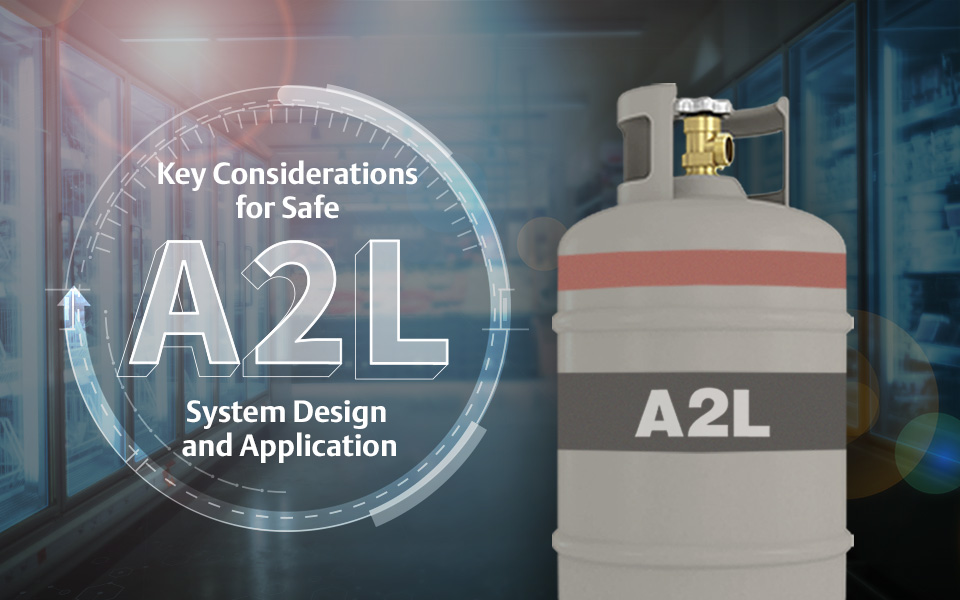Key Considerations for Safe A2L System Design and Application

The regulatory wheels are currently in motion to approve A2L refrigerants in commercial refrigeration. With lower-global warming potential (GWP) ratings below 300 and safety standards enabling higher refrigerant charges, lower-flammability A2Ls can unlock a wide range of new application and equipment possibilities. This blog and our companion video series, A2L Fundementals, will explain the key considerations for the safe design and application of A2L refrigeration equipment.
Throughout the refrigeration supply chain, stakeholders may have many questions about the application of A2Ls. For original equipment manufacturers (OEMs), system designers and service technicians, A2Ls introduce new considerations for equipment safety, system design strategies and servicing best practices.

What does the A2L “lower flammability” classification mean?
Understanding the flammability characteristics of A2L refrigerants is a good starting place when evaluating equipment design and applications. Although the refrigeration industry is still largely unfamiliar with A2Ls, the use of flammable refrigerants is not new. R-290 (aka propane) has been safely used refrigeration applications for many years and is classified by ASHRAE as a higher flammability refrigerant. The relative differences in A2L and A3 flammability characteristics are important to consider when ensuring safety and assessing potential risk factors.
Compared to R-290, A2L flammability characteristics are lower across all key metrics.
Lower flammability limit (LFL) — The LFL of typical A2Ls being considered in commercial refrigeration is roughly eight to 10 times higher than R-290. Thus, A2Ls are less likely to create the conditions necessary for ignition than equivalent concentrations of R-290. LFL is a key factor used by safety standards to determine the allowable refrigerant charge per each refrigeration equipment type and system design. Thus, R-290 is allowable in low charge limits, and A2Ls are being considered in significantly larger charges for higher-capacity applications.
A flammable event can potentially occur when the concentration of leaked refrigerant exceeds its LFL threshold and is exposed to a source of ignition (e.g., flame or high-ignition energy source).
Minimum ignition energy (MIE) — A2L MIEs are significantly higher than R-290. R-290 can be ignited by lower energy sources such as a static electrical discharge. A2Ls need more energy to ignite, typically requiring exposure to an open flame or strong electrical energy source — making them relatively safer to use around certain electrical components.
Burning velocity (Su) — If the LFL and MIE create the conditions necessary for ignition, Su denotes the velocity of the flammable event. R-290 has a nearly explosive effect, spreading quickly at 46 cm/s, whereas the Su for A2Ls is much lower, at less than 5 cm/s.
Minimizing the possibility of ignition is the primary safety consideration for all flammable refrigerants. But with a lower flammability classification than R-290, A2Ls have less intense flammable characteristics and are less likely to ignite. This expands the potential for A2L use in higher charges across a wide range of commercial refrigeration equipment types and applications.
A2L safety measures for equipment and system design
The Underwriters Laboratories (UL) 60335-2-89, 2nd edition product safety standard provides guidelines for the safe use of A2L and A3 refrigerants in commercial refrigeration. Per the UL 2-89 standard, requirements for equipment design, construction and installation are defined for self-contained units and remote systems.
Self-contained is defined as equipment consisting of a completely factory-assembled, factory-charged and factory-tested refrigeration system, in which all refrigerant-containing parts are permanently connected at the factory. Thus, the evaporator, condenser and compressor are all part of a packaged unit, which is a common design strategy for reach-in display cases. Per the UL 2-89 standard, A2L self-contained charge limits are based on whether the unit has a closed-door (or drawer) or open- design. Self-contained equipment charge limits are calculated as follows:
- m1 = 8 m3 × LFL for closed-door (or drawer) designs
- m1 = 13 m3 × LFL for open-style designs (without doors or drawers)
Using R-454C as an example — with an LFL of 0.291 kg/m3 — the refrigerant charges in closed and open cases are as follows:
- 1 lbs. of R-454C in a closed case
- 3 lbs. of R-454C in an open case
These higher charge limits would greatly expand the cooling capacities found in current self-contained systems charged with R-290. Any self-contained system charged with more than 150 grams of a flammable refrigerant must also pass Annex CC requirements – the test method for determining gas concentration beyond the boundary of the appliance.
For self-contained equipment that stays below the m1 charge and passes the UL 2-89 standard’s Annex CC testing requirement, leak detection or additional risk mitigation is not required. Annex CC also requires OEMs to verify that in the event of a leak their equipment will not exceed 50 percent of the refrigerant’s LFL for a period exceeding 5 minutes.
In remote systems — such as condensing units or mini scroll packs — the use of A2L refrigerants would enable a new generation of lower-GWP, higher-capacity solutions. Unlike self-contained units, remote systems are mostly assembled, charged and installed in the field. As such, they will require adherence to additional safety requirements and considerations.
UL 2-89 (2nd edition) provides guidance on how to calculate A2L charge limits in remote and/or field-erected systems, where charge limits are proportionate to the application size and/or cooling requirements:
- m2 = 52 m3 × LFL
- m3 = 260 m3 × LFL
Using R-454C as an example, the maximum allowable charge size would be 76.2 kilograms (166 pounds) and deliver up to 50–60 HP of cooling capacity. However, utilizing larger charges of A2L refrigerants in remote systems may require additional safety mitigation measures. Specific charge calculations and mitigation strategies will be based on the LFL of the A2L refrigerant, the area of the installation space and other relevant application conditions.
Following the guidance within Annex 101.DVU and Annex 101.DVG requirements of the UL 2-89 standard, systems should be designed to detect, isolate and disperse A2L refrigerant leaks via a combination of tools and controls:
- Sensors integrated into systems and cases to detect leaks
- Isolation and/or safety shut-off valves (SSOVs) in the refrigeration system to limit releasable charge
- Electronic controls with A2L logic to perform required actions in the event of a leak — such as shutting off the compressor and/or other components
- Ventilation and/or circulation fans within cases or walk-in units
Electronic component considerations
Working with flammable refrigerants in a commercial refrigeration system requires special attention to the electrical componentry found within compressors and condensing units as well, such as:
- Relays/contactors and/or devices used for switching electrical currents on/off
- Controllers
- Variable frequency drives (VFDs)
- Electrical enclosure (box) within which a full system may be contained
Per UL 2-89 (2nd edition), these common components must be certified individually (per Annex 101.DVL) or within an enclosure (per Annex 101.DVM).
To explore these topics further, please view the A2L Fundamentals video series. Visit our A2L resource center to learn more about how Copeland is preparing its compressors and components for use with A2L refrigerants.

Six Ways to Reduce Food Waste by Tracking the Supply Chain
by Gerd Uitdewilligen | Cold Chain
*Emerson’s Climate Technologies business is now a new standalone company: Copeland. Over the next...

Protect Valuable Shipments in High-Crime Areas
by Lissandra Rodriguez | Cold Chain
*Emerson’s Climate Technologies business is now a new standalone company: Copeland. Over the next...

Real-time Tracking Protects Valuable Mango Cargo
by Andres Toro | Cold Chain
*Emerson’s Climate Technologies business is now a new standalone company: Copeland. Over the next...
The post Key Considerations for Safe A2L System Design and Application appeared first on Copeland E360 Blog.